Key takeaways:
- Photography collaboration enhances creativity by introducing diverse perspectives and techniques.
- Building emotional connections during projects fosters friendships and deepens the creative experience.
- Flexibility and clear goal-setting are essential for the success of collaborative photography projects.
- Communication and openness to feedback can resolve tensions and elevate the quality of work in collaborative settings.
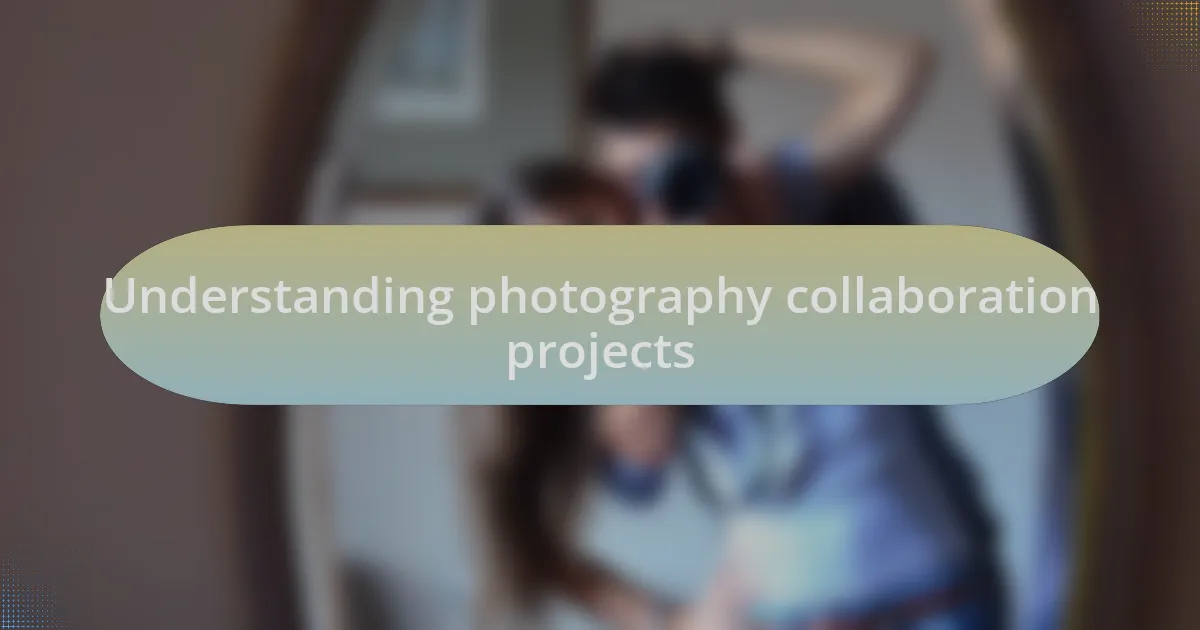
Understanding photography collaboration projects
Photography collaboration projects are exciting ventures where creative minds unite to bring a common vision to life. I remember one project where I teamed up with two other photographers to document a local festival. Each of us had unique perspectives—one focused on candid shots, while another aimed for vibrant portraits. This diversity really enriched the final outcome, showing how collaboration can enhance creativity.
Have you ever considered how collaboration can push you out of your comfort zone? In my experience, working with others challenges you to try different techniques and styles that you might not explore on your own. For instance, during a collaborative shoot, I found myself experimenting with lighting in ways I never thought possible. It opened my eyes to new possibilities and helped me grow as a photographer.
The emotional bond formed during these projects can be incredibly rewarding. I recall a time when we wrapped up a shoot and felt a shared sense of achievement. The exhilaration of combining our creativity led to friendships that extended beyond the camera. It made me realize that photography isn’t just about the images; it’s about the connections we build along the way.
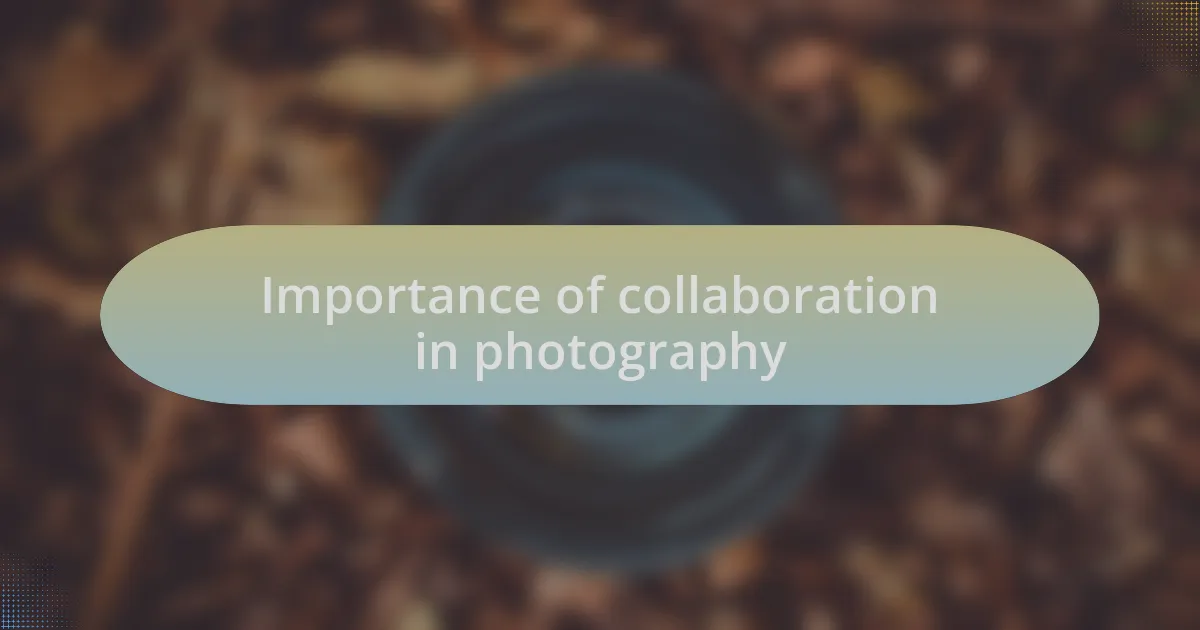
Importance of collaboration in photography
Collaboration in photography is vital because it opens doors to fresh ideas and techniques. I vividly recall a project where I partnered with a graphic designer to create promotional material for a small business. Her expertise in visual design challenged me to think beyond just taking pictures; I had to consider how my images would interact with text and layout. Have you ever faced the need to step beyond your usual scope? That experience taught me the importance of merging different skill sets to realize a fuller vision.
Engaging with fellow photographers offers an invaluable chance to receive feedback and foster growth. During one of my collaborative projects, I shared my work with someone whose style was vastly different from mine. Each critique she offered pushed me to reconsider my compositions and challenged me to refine my techniques. Isn’t it fascinating how others can see things in your work that you might overlook? That exchange of ideas not only led to improved photography but also deepened my appreciation for diverse artistic approaches.
Moreover, working together cultivates a sense of community that is hard to replicate alone. I remember participating in a weekend workshop where we paired up for practical shoots. The excitement of sharing our successes and learning from each other’s failures created bonds that went beyond just the activity. How often do we get to experience such collective enthusiasm? Through collaboration, I discovered that photography can be more than an individual pursuit; it’s a shared journey that enriches the creative process.
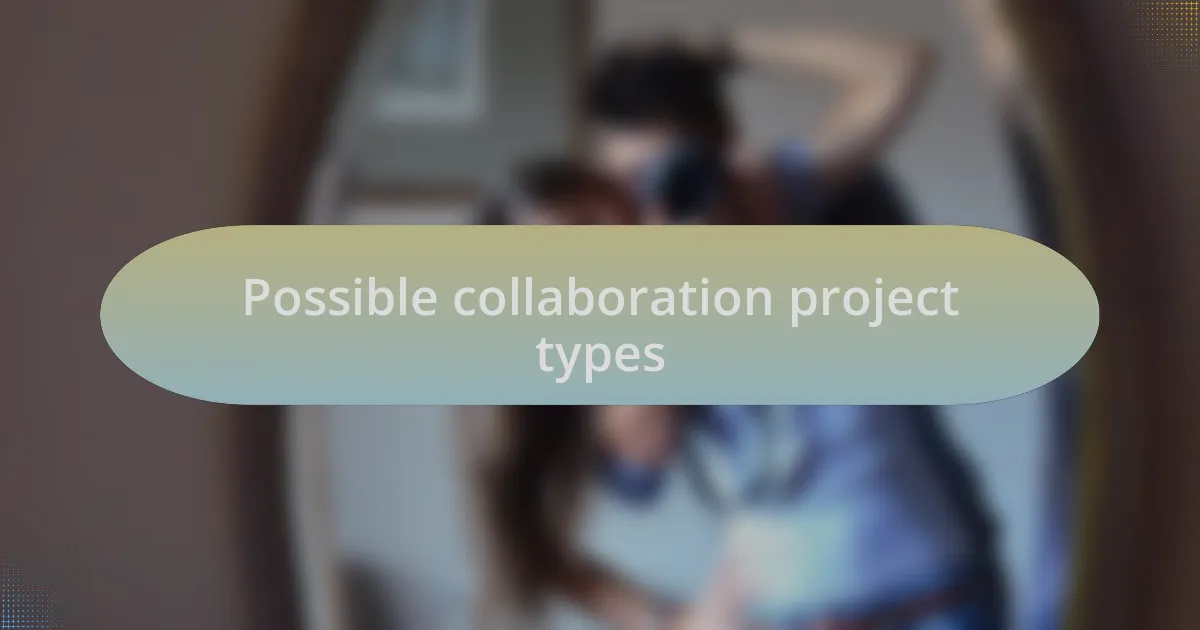
Possible collaboration project types
When it comes to collaboration projects, one exciting type I’ve explored is themed photo walks. Picture this: a group of photographers gathering in a vibrant neighborhood, each capturing their perspective on a common theme like “urban resilience.” I remember one memorable session where we aimed to portray community spirit. As we shared our images afterward, each interpretation sparked a rich discussion, revealing layers of meaning I had not considered. Have you ever wondered how a single subject can inspire such varied interpretations?
Another intriguing project type is collaborative exhibitions. In one instance, I teamed up with five other photographers to create a collective display highlighting the beauty of nature in our local parks. Each of us contributed a series of images, and we transformed a small gallery into a vibrant narrative of our shared environment. It not only showcased our individual styles but also united our storytelling efforts, drawing in viewers and provoking their thoughts. Wasn’t it amazing to witness how our distinct visions created a more profound experience for those who attended?
Lastly, consider participating in editorial projects where photographers and writers join forces. I took part in one such endeavor, collaborating with a writer to document the stories of local artisans. Through this partnership, my photographs were enhanced by her words, and her storytelling was enriched by my visuals. This synergy sparked discussions about the role of narrative in photography, making me realize how powerful stories can be when paired with compelling images. Have you ever considered how a well-crafted narrative can elevate the impact of your photographs?

Finding the right partners
Finding the right partners in photography collaboration is crucial for a successful project. I once teamed up with a fellow photographer who had a completely different style from mine. At first, I was unsure how we could mesh our visions, but I quickly realized that our contrasting approaches led to innovative ideas. How often do we overlook potential partnerships simply because we expect everyone to think alike?
Moreover, I believe it’s important to choose partners whose values align with yours. I recall collaborating with a passionate environmentalist who shared my commitment to sustainability. Our discussions were not just about photography techniques but also about the impact we wished to make through our work. This alignment fueled our creativity and purpose throughout the project. Have you ever thought about how shared values can become the foundation of a powerful collaboration?
Finally, don’t underestimate the power of chemistry in a partnership. I’ve worked with photographers where the energy felt electric, making the entire process enjoyable and productive. In contrast, I’ve also experienced collaborations that felt forced, lacking the rhythm needed for creativity to flourish. Reflecting on these experiences, I recognize the significant role that personal connection plays. Isn’t it fascinating how the right chemistry can transform a good project into an unforgettable one?
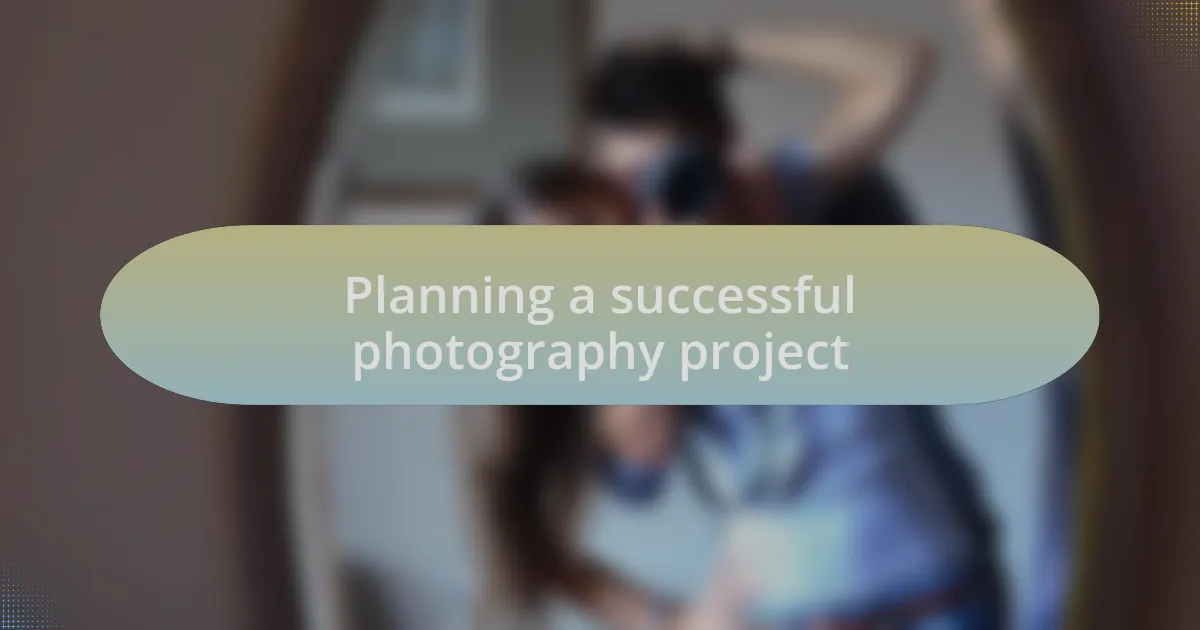
Planning a successful photography project
When planning a successful photography project, setting clear goals is essential. I remember embarking on a community-focused initiative aimed at capturing local stories. Initially, we had multiple ideas floating around, but it was the moment we pinpointed our clear objective—showcasing the resilience of our neighborhood—that everything fell into place. How often do we start without a specific target in mind, thinking we can figure it out as we go?
Another key element is the pre-project research. I once didn’t fully appreciate the value of scouting locations ahead of time. On a project about urban landscapes, I arrived at a chosen site only to discover the lighting and background were far from ideal. After that experience, I made it a point to plan meticulously, visiting potential sites at different times of day. Have you ever faced challenges that could have been avoided with a bit of extra preparation?
Finally, I’ve learned the importance of flexibility during the project. In one of my collaborations, unforeseen weather conditions forced us to pivot our plans. Instead of letting it ruin our day, we embraced the moment and ended up capturing some of the most striking images in the rain. This adaptability not only saved the day but also enhanced our creative output. Do you find that being open to change can lead to unexpected and beautiful results?
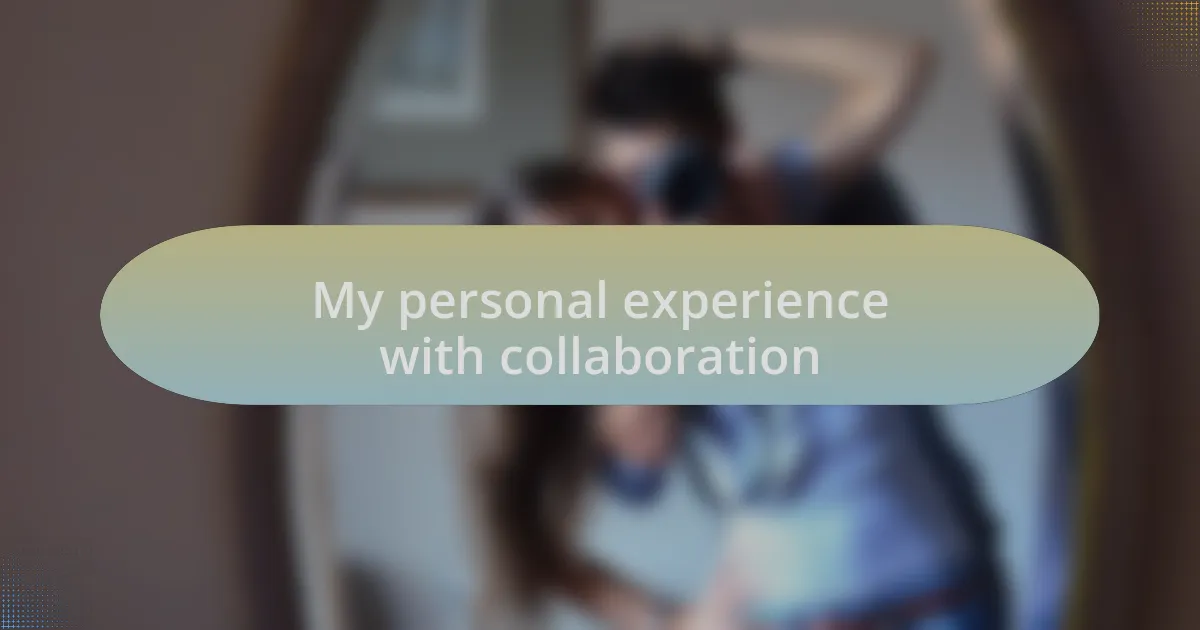
My personal experience with collaboration
Collaboration in photography has always been a double-edged sword for me. I recall my first major project teamed up with several talented photographers. As excited as I was, I found the differing styles and visions challenging. However, as we shared our perspectives, I realized that we were not just creating a body of work; we were blending our stories into something greater. Have you ever felt that thrill when individual visions align to create a masterpiece?
One memorable experience was during a portrait series where we aimed to capture the essence of our subjects through their environments. Working with a stylist added another layer of creativity. I vividly remember a moment when our model inspired impromptu poses, leading us to some of the most organic shots. I learned then how valuable it is to keep an open mind—what unexpected moments have you embraced during your own projects?
There are also moments of tension when collaborating. In one project, disagreements over creative direction nearly led to a fallout among the team. I distinctly remember feeling frustrated, yet I soon understood the importance of communication. We held an open session to voice our thoughts, and by allowing space for each opinion, we emerged with a stronger vision. How often do you find that hashing things out can lead to breakthroughs in collaboration?
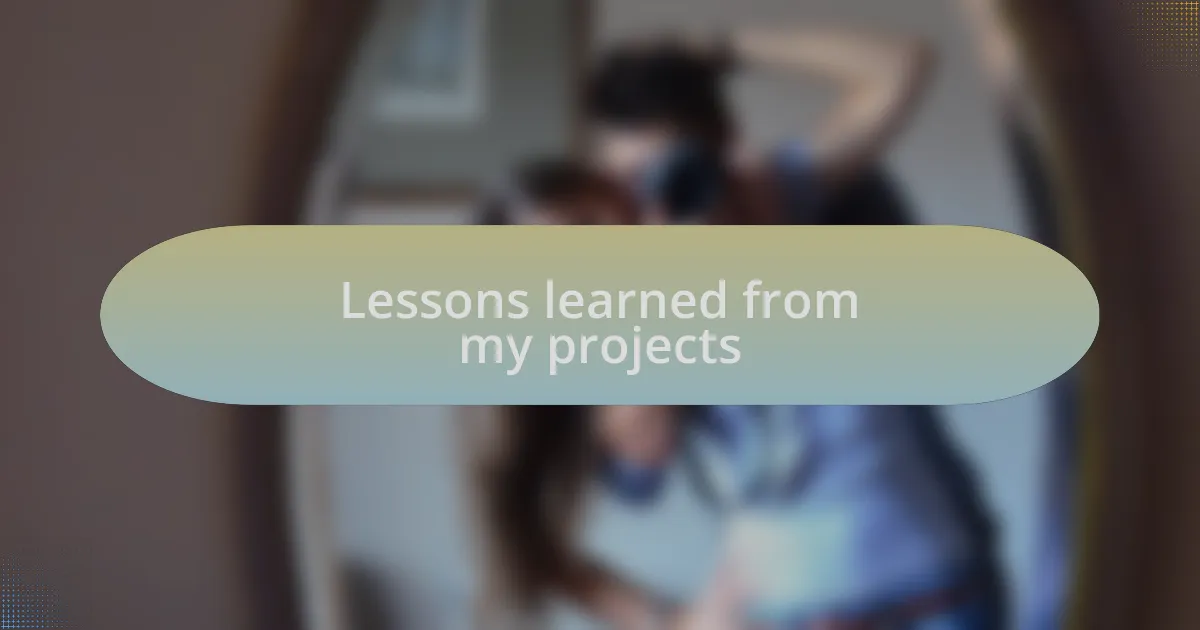
Lessons learned from my projects
When reflecting on my collaboration projects, I’ve learned that patience is not just a virtue; it’s a necessity. During a landscape shoot in collaboration with a fellow photographer, we encountered unexpected weather changes that left us without the perfect lighting we envisioned. Instead of panicking, we took a step back, used the moody skies to our advantage, and ended up with a series that felt raw and authentic. Isn’t it fascinating how sometimes, the things we initially perceive as setbacks can lead to unexpected beauty?
I’ve also come to realize that setting clear expectations at the outset can save a lot of heartache down the line. In one project, our team lacked a cohesive vision, which led to miscommunication and frustration. I remember spending hours reviewing images that simply didn’t align with our intended message. It wasn’t until we defined our goals and discussed each person’s role openly that we finally started to gel as a unit. Have you ever found yourself in a situation where clarity transformed chaos into creativity?
Embracing feedback has been another crucial lesson. Early on, I was hesitant to share my work for fear of judgment. But during a collaborative exhibition, I received constructive criticism from collaborators that opened my eyes to new techniques and perspectives I hadn’t considered. I felt a wave of growth, which made me wonder—how can opening ourselves to others’ insights elevate our art to new heights? Each experience has underscored for me that collaboration is as much about receiving as it is about giving.